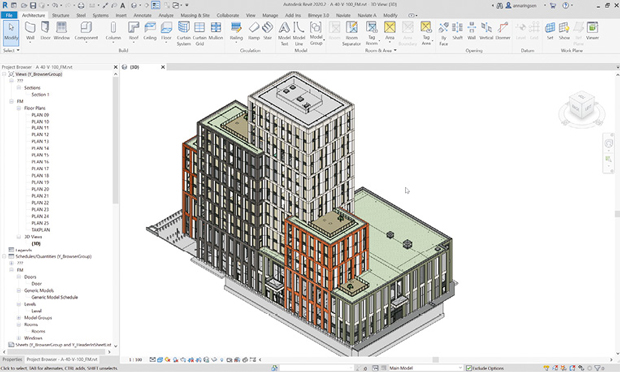
 Paul McCarthy, CTO at Service Works Global explores the benefits of digitalisation in the built environment and advises how FMs can start the digital journey as illustrated by two case studies
Paul McCarthy, CTO at Service Works Global explores the benefits of digitalisation in the built environment and advises how FMs can start the digital journey as illustrated by two case studies
Ask a range of professionals in the construction, design and FM sectors to describe building information modelling (BIM) and you’ll likely get a mixed set of responses. Some may be unfamiliar with BIM; others might think that it is simply a piece of technology implemented during the construction of a building.
The truth is that BIM is a powerful tool for any business working towards a digital transformation. That’s one of the reasons that the UK BIM Alliance(i), rebranded to ‘nima’ late last year (nima is not an abbreviation, but the Greek word for thread). The rebrand was recognition of the fact that the scope of digital transformation is much wider than BIM, and includes digital twins, FM and maintenance, business efficiency, and sustainability.
For me, the best way to explain BIM to someone unfamiliar or unsure with the concept is to describe it as a process of information management and sharing. Once we have this understanding, conversations can progress about how we begin the journey towards a smart building and the various systems that need to be in place. For some, that journey begins at the construction stage.
BIM DURING CONSTRUCTION
The UK Government has been promoting the adoption of BIM in the construction industry for more than a decade, and over that time its use has grown significantly – and for good reason.
BIM enables collaboration among project stakeholders by providing a common platform for sharing information. For example, architects, engineers, and constructors can all access the same model, which ensures that everyone is working from the most up-to-date information.
BIM also improves coordination among design and construction teams by allowing them to detect and resolve conflicts before construction begins. This increases efficiencies and reduces costs, as problems are detected before work is underway.
It also plays an important role in compliance by allowing teams to check the design against building codes and safety standards.
Buildings constructed with the support of BIM information can retain that data for the long run and reap the benefits.
A common misconception I come across is that if an existing building does not have a BIM model in place, it’s either not worth the cost or too difficult to implement. I’m pleased to say that this couldn’t be further from the truth.
UTILISING BIM DATA IN EXISTING BUILDINGS
The UK Green Building Council(ii) states that 80 per cent of the buildings we’ll be using in 2050 have already been built, which is why it would be remiss of us as an industry to focus too much on new builds when we have so much existing stock to digitally transform.
Fortunately, the process of developing a digital model and gathering the data does not have to be time-consuming or expensive. We recently built a digital representation of an 8000 m2 school in Sweden over the course of a weekend, using laser scanning technology, meaning there was no disruption to the students.
BIM models are commonly created through the use of 3D laser scanning and georeferencing technology. Once set up, the fully operational and data-rich model has some immediate benefits. For example, the new digital model can replace floorplans that may well be outdated. This will be vital for any future retrofitting or construction work, as all relevant parties can access the model, safe in the knowledge that it contains up-to-date information.
As far as smart buildings go, the next step in the journey is implementing sensors to capture real-time data. Sensors can track a wide array of things, from room occupancy levels to how full a bin is – when a cleaner can then be pinged with a message to empty that bin.
With so many possibilities for data collection it can be tempting to add sensors across an entire estate and track everything you can. However, my advice is to start small. There is no point capturing data that you won’t have a use for or won’t have someone designated to analyse and report back.
Consider what will be most valuable for your organisation and start there. One area that all businesses will be impacted by, regardless of sector, is energy, especially as the Government support programme is changing at the end of the month(iii).
By analysing sensor data about which rooms of a building are (or are not) used, informed decisions can be made about the lighting and heating requirements for those spaces. The data may dispel pre-existing assumptions of which spaces employees use, and when. The larger the estate, the more impactful strategic decisions like this can be, helping to drive sustainability and cut energy costs.






